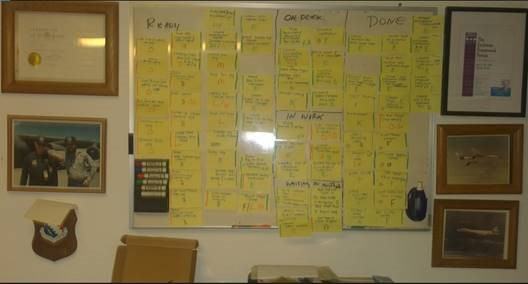Personal Kanban One Month Later
Blog: Brian's Blog - Enterprise Strategy, Architecture and Management

Its been slightly more than a month since I had started my personal productivity experiment. This Friday afternoon I’ll be looking at all my Kanban cards (4 full pads of Post-it Notes**). Completed, In Process, On Hold for Someone Else’s Action, and Ready Queue. Part of that retrospective is to look for patterns and analyze where not only throughput, but effectiveness can be improved.
Just a cursory look at tasks completed provides no surprise; where I have no dependencies upon anyone on executing a task these tasks are completed quickly with a few exceptions, home projects and maintenance activities. Where there are coordination or decision dependencies many tasks are often in the hold queue waiting for input than the level of effort to complete. The small insight I have into this delay is due to just a few factors:
· First the nature of opportunities is such that others need to jump on these immediately. Whether that is to assess these or actively pursue those interruptions are necessary but still delay current activities.
· Second, schedule integrity of all considered. This often is caused by the prior, but often is because priority changes are not communicated until after an appointment has been missed. When I was at Microsoft, this was a common issue along with overcommitting schedules (double or triple booking). Typically, many had back-2-back meetings though they knew it took 10 to 15 minutes to go between meetings. The results of which was having to go over materials that were just covered 10 minutes prior. Many times, this could have been avoided by keeping schedules on-line, ensuring that you don’t request a meeting time that was already scheduled, or sending a notification to others as soon as you know you have a conflict.
· There are a few other reasons for such, however, what I’ve seen is the first reason dominating those dependency delays.
To address such from my end I’ve tried to keep some specific office hours, not quite free time but time where I do tasks that can be interrupted with little detriment to schedules dates. One executive management’s end they attempt to have regular 1:1 meetings or stand-ups with teams, but again opportunities impact such. Since I don’t have insight to management’s day-2-day activities and challenges I’m not sure of a means I could propose to help attenuate such interruptions or even if doing so would be beneficial.
The second insight which was not surprise and was pointed out in both books — Personal Kanban and Making Work Visible—was that of shifting priorities. Here again changes in task execution priorities revolved around opportunities that arise suddenly. I’m fortunate to be working in an area that has limited impact by such, but this can’t be avoided in a small firm. The one saving grace to this, is that we have a highly motivated, cooperative and smart team. So, when a challenge arises it’s all hands-on deck almost before a request is made hands are raised to help.
The last insight I have before delving deeply into the statistics later today is that creating the Kanban board and pushing many items back into the ready queue limiting my work in progress has resulting in what I believe has been higher quality output and more throughput.
For my readers I would highly recommend reading and experimenting with the concepts in Personal Kanban and Making Work Visible.
Has this made a positive impact to the rest of the firm. I don’t know yet. I plan to bring up the topic during our strategic planning session and see if others are interested in trying these concepts out, several of which require a little more coordination/commitment to our planned team stand-ups.
**It should be noted that these cards cover tasks not the major projects these support, those some of these cards represent complete deliverables.
Leave a Comment
You must be logged in to post a comment.







